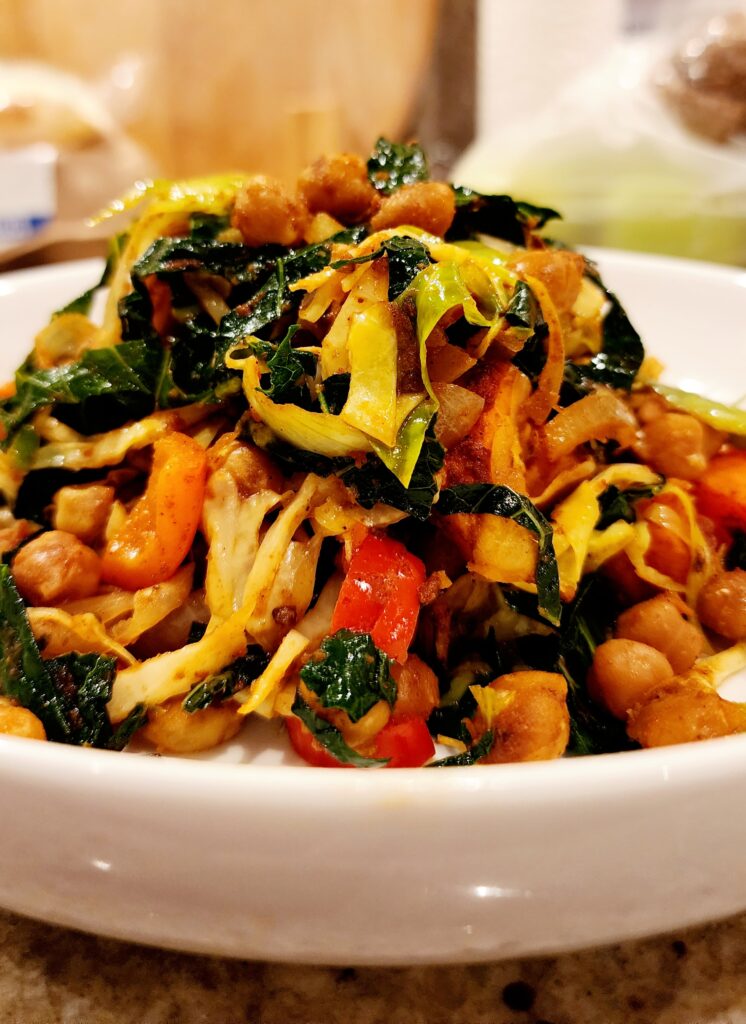Different ways of preparing vegetables
Steaming broccoli, cauliflower, green beans, and snap peas on the stove
Roast. Works with bell peppers, asparagus, carrots, onions, broccoli, cauliflower, zucchini, Brussels sprouts, etc:
Sautee: Cooked on the stovetop! Simple, delicious. Zucchini, kale, mushrooms, and cabbage all taste great with just a little oil and salt and are super easy to prepare.
Bake vegetables in a vegetable frittata, zucchini lasagne, rissoles, and vegetable sausage rolls.
All these options can be paired with basically any protein for a delicious and healthy meal (or eaten as a healthy, stand-alone snack!).
If you try to cook a vegetable, burn it to a crisp, and “fail,” I’ll still be proud of you. We all suck at stuff the first time, so the sooner we get those first few attempts out of the way, we can get to get better and then we all win.
Cook a vegetable within 3 days of bringing them home.
Tip: You can cook large quantities and then you’ll have MANY more days before the food goes bad.
How can you get more veggies into you if you are struggling?

Essentially, it comes down to “hide them, blend them, pair them, or cover them!”
Blend them up! Add frozen spinach or kale to your smoothies. This is my personal favourite and is part of the reason I get so many servings of vegetables every day.
Make a combo bite with a food you like: If you can learn to cook something chicken and veggie stir-fry, you can make sure that every vegetable bite also has plenty of chicken.
Make them into different styles and shapes.
Zucchini noodles are tasty when mixed with other awesome foods.
“Cauliflower rice” or “mashed cauliflower.” With butter and salt, cauliflower can taste like rice or mashed potatoes on a plate with the right foods.
Dip them! You can dip broccoli florets, cauliflower florets, or carrot sticks in hummus or guacamole. Think of the vegetable as the delivery vehicle for your favourite dipping food!
Add spinach, chard, or kale to your homemade chilli or guacamole. You won’t notice the difference in the taste, and you’re sneaking extra vegetables into your meals.
All the above examples accomplish the same goal: Getting more vegetables into your system.
How to buy vegetables from the shop for maximum nutrient viability.
Asparagus: Choose firm, smooth, brightly coloured stalks with compact tips. Avoid limp stalks. Choose stalks of equal thickness to ensure even cooking times.
Broccoli: Choose with firm stalks, tight florets, and crisp green leaves. Avoid yellowed or flowering florets.
Brussels Sprouts: Choose firm, compact, bright green heads. Avoid sprouts with wilted or loose outer leaves.
Let colours guide you – get different combinations of nutrients by putting a ‘rainbow’ of colours (green, white, yellow-orange, blue-purple, red) on your plate.
Eat with the seasons – this is nature’s way of ensuring our bodies get a healthy mix of nutrients and plant chemicals.
Your commitment if you don’t like vegetables:
For the next four weeks, I want you to try ONE new vegetable each week:
- Use the 20-second courage rule to try a new vegetable as a side when you go out to dinner.
- Buy a new vegetable at the grocery store and learn to prepare it.
- Add vegetables discreetly to your favourite meals (mix in with your smoothies, add to your omelettes, etc.).
- Learn to prepare a vegetable in a new way. Whether it’s roasting them in the oven or grilling them on the BBQ, try a different way to prepare a vegetable and level up your cooking skills.
Recommended Portions of vegetables:
This is only a guideline you can have as much vegetables as like to have and do not be limited by this list.
Leafy greens:
Spinach, kale, mustard leaf, mixed salad leaf, Rape, Dandelion, Pumpkin leaves
Recommended at least 6 cups per week.
Berries:
Strawberries, raspberries, blueberries, blackberries
Recommended at least 2 cups per week.
Cruciferous Vegetables:
Broccoli, Cabbage, kale, cabbage
Recommended at least 5 servings per week.
Gut health promoters
Such as cultured and fermented foods like yogurt, kimchi, kombucha, miso, and sauerkraut, as well as prebiotics.
Recommended daily or at least several times per week.
Tea
Such as green, white, oolong, and black teas, lemon water, ginger tea
Recommended at least 1 cup per day.
Types of Common Vegetables
| cauliflower celery cucumbers eggplant pumpkin mushrooms okra onions zucchini squash butternut squash carrots |
| broccoli collard greens kale romaine lettuce spinach artichokes asparagus beets brussels sprouts cabbage red peppers green peppers bok choy |
You want to learn more





